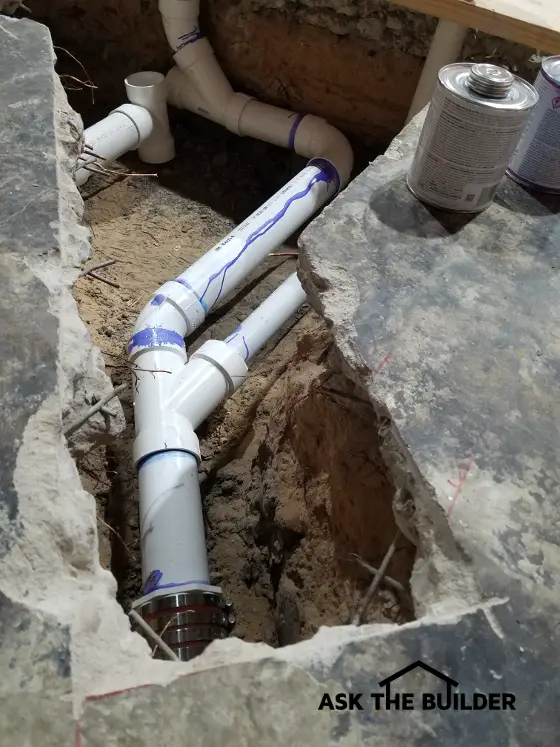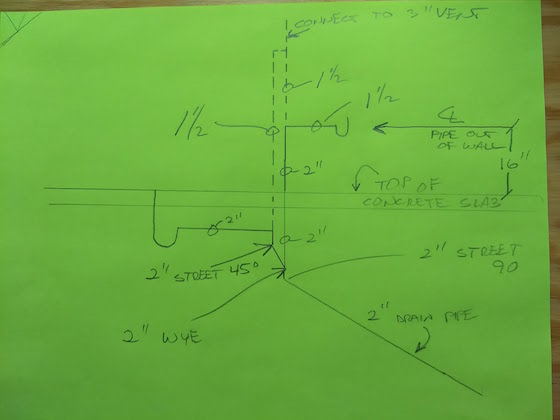DIY Plumbing Challenges

Here’s a homeowner’s attempt at installing a DIY toilet. He’s already made two grave mistakes. (C) Copyright 2018 Tim Carter
Plumbing Mistakes
I’m blessed. Not only do I get emails each day from readers like you, but I also get questions from the Ask Tim page at my AsktheBuilder.com website. Believe it or not, these questions are never tiring and it’s like Christmas morning when I open them. The high-resolution photos that often accompany the inquiries are like magic eye candy to me. My wife thinks I’m nuts!
Today was no different. Wayne reached out to me from Houston, Texas. He decided that he was going to do some serious DIY plumbing at his house and as he put it, “I’ve racked my brain and can’t come up with a code-approved way to make this happen.”
Wayne chose to have me help him.
He not only asked for help on the phone (CLICK HERE), but he also had me draw out on paper exactly how the pipes should be installed.

Here's part of the plans I drew up for Wayne. I call out special fittings in many cases to help make the systems work. Copyright 2018 Tim Carter
It just so happens I’m a master plumber. I’ve been one since age twenty-nine. I did all the plumbing on most of my jobs and thoroughly enjoyed it. Designing and installing plumbing drain and vent lines is like a giant 3D puzzle to me. As crazy as it sounds, it’s fun.
I’m not going to try to transform you into a plumber with this column, but I’d like to share some pointers that might come in handy if you decide you want to do what Wayne’s trying to accomplish. If you want to leave the job to a real plumber, the tips might allow you to verify he’s using the best practices at your home.
Transporting waste water from your home to a city sewer or your own septic tank is serious business. In the late 1800s when indoor plumbing started to take hold, plumbers were treated with equal, or greater, respect than physicians of the time. Once it was understood that sewage was the cause of serious disease, anyone who was willing to pipe it away safely was considered to have a super power of sorts.
The drain and vent pipes in your home mimic what Mother Nature does on a much grander scale. The issue is most people don’t stop to ponder what they see with their eyes.
Look at how creeks, streams and rivers work. Small streams eventually connect with larger rivers. When they intersect, the angle is rarely a hard 90-degree turn but more often some gentle angle close to 45, 30 or 22 degrees.
The blood vessels in your body are designed the same way. Don’t ignore technology that Mother Nature has perfected when it comes to the best way for liquids to flow.
You should design your wastewater pipes in a similar manner for the most part. It’s a bad plumbing practice to have a hard 90-degree bend in a horizontal drain line that’s buried in a slab or otherwise hidden. If you have to make a 90-degree bend, use two 45-degree fittings and put a small piece of straight pipe between the fittings if possible.
It’s fine to have a larger-radius (sweep) 90-degree bend at the base of a vertical drainage stack where the wastewater starts to travel horizontally. It’s also a good idea to have a sweep 90-degree fitting where a drain pipe pops out of a wall for a kitchen, vanity or laundry sink.
Drain-cleaning flexible snakes can navigate around these sweep 90 bends but may drill through a plastic PVC or ABS a hard 90-degree fitting in by mistake. You can use those hard 90s all day long in your vent pipes that supply your plumbing system with much-needed air.
Don’t forget about pipe slope. Use gravity’s magic force to get your solid and liquid waste out of your home. All drain lines should have a minimum fall of 1/8 inch per foot of horizontal run. Some codes allow 1/4-inch of fall per foot.
If you slope the pipe much more than 1/4-inch per foot, you can set yourself up for future clogs as the liquids may outrun the solids in steep-pitched pipes. The solid waste may sit in the pipe and accumulate creating a clog. Avoid the temptation to create lots of fall in your horizontal drain piping.
If you’re unclear about the magic vent lines in your home, you should watch a video I taped. This video will get you up to speed so you don’t make critical venting mistakes!
Column 1231
2 Responses to DIY Plumbing Challenges